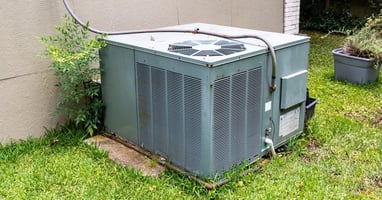Finding the right air conditioning system for your home isn’t always easy since there are various...
Packaged vs. Split AC Systems: Which One Is Better for You?

Buying a new air conditioning system for your home is one of the best ways to increase comfort during those hot summer months. The perfect unit comes down to knowing which options are the best for manufactured homes: packaged and split AC systems. Both come with differing benefits to your comfort, energy bills, and home aesthetics. In our guide, we’ll explain what packaged and split AC systems are and which one is best for you.
Packaged AC Systems
A packaged AC system is a popular option for manufactured homeowners due to its compact size and minimal ductwork requirements. In this system, the evaporator, condenser, compressor, and air handler work together within a single cabinet, typically installed on a concrete pad beside your home or on the rooftop. These systems distribute cooled air through existing ductwork or newly installed ducts throughout your living space.
The Pros of Packaged AC Systems
Aside from being ideal for properties with limited space, packaged AC systems also have other advantages. Here are some of the pros of this type of air conditioning system.
Easy Installation
Since a packaged system houses everything in one unit, professionals can install these systems quickly and easily, often without requiring any major modifications. Not only does this save time, but it also reduces installation costs, giving you more money to spend on other areas of your home.
Low Maintenance
Packaged AC systems are relatively easy to maintain due to their all-in-one design. If the system doesn’t seem to work properly, professionals only need to inspect one area during their assessment to diagnose the issue.
Cost-Effective
Most packaged AC systems are less expensive than mini-splits, as they don’t require special components such as coolant lines or an outdoor unit. This makes them a great choice for budget-conscious homeowners who want to invest in a reliable and efficient cooling system without overspending.
The Cons of Packaged AC Systems

While there are numerous benefits to buying a packaged AC system, nothing is perfect, and there are a few downfalls to consider.
Not Ideal for All Homes
Packaged systems are a compact HVAC option, but they aren’t suitable for large, multi-story properties. Their centralized design struggles to meet the varying cooling needs of different rooms or zones. For properties over 2,000 square feet, multiple packaged units or alternative solutions are often necessary.
At Risk of Weathering
Although manufacturers design packaged systems to withstand the elements, outdoor conditions can still damage your unit. In the Midwest, we often experience rain, snow, and humidity, which can all contribute to rust or corrosion. Likewise, small animals may see it as the perfect place to make a home and can damage the unit’s internal components.
Split AC Systems
A split system may be more compact than central AC, but it’s still larger than a packaged system. Mini-splits consist of an indoor air handler and an outdoor condensing unit, connected by refrigerant lines. The outdoor unit houses the compressor and condenser coil, while the indoor unit containd evaporator coils and blowers that deliver cooled air directly to individual rooms or zones. Refrigerant circulates between these components through insulated copper lines that technicians route through walls or ceilings.
The Pros of Split AC Systems
Like any appliance, there are several pros to mini-splits.
Energy Efficient
Since split systems don’t require ductwork, they are more energy efficient than central air conditioning systems. No energy is lost because there are no leaks or unused areas in the home, such as an attic if you live in a traditional home.
Additionally, many mini-splits have Seasonal Energy Efficiency Ratio (SEER) ratings, which measure an air conditioner’s cooling output divided by the energy it consumes. This rating is typically higher than traditional central air conditioning systems, meaning they are more efficient at cooling your home while using less energy.
Zoned Cooling
A mini-split allows you to have more control over the temperatures in various areas of your house. If you live in a traditional home, you may consider buying a split system for your bedroom to keep it cool on summer nights. However, if you live in a small manufactured home, you could opt for a single mini unit for the entire home, thanks to its compact size.
Quiet Operation
Nobody wants a noisy air conditioning unit that you can hear while it’s running. Manufacturers design mini-splits to work quietly, allowing for a peaceful and comfortable living environment. This is particularly useful for individuals who work from home and need a quiet space to concentrate.
The Cons of Split AC Systems
No AC system is perfect, and knowing the cons helps you make the most informed decision for your home. Here are some disadvantages of split AC systems.
Higher Upfront Costs
Mini-split systems typically cost more upfront than traditional HVAC systems, primarily due to their intricate installation process and advanced technology. Although they don’t require ductwork, each indoor unit must be precisely mounted and connected to the outdoor unit by skilled professionals, adding to labor costs.
Require Indoor Space
While split systems don’t require as much room as central AC, they still need some, and if you have a smaller home, space is a premium. The indoor units of mini-split systems can occupy wall or floor space, depending on the type of unit you select.
Choosing the Right System

Still not sure whether packaged or split AC systems are best for you? Below, we’ve detailed the key areas to compare.
Consider Your Space
Available installation space determines system feasibility more than personal preference in many cases. Properties with limited outdoor space may accommodate split systems more effectively, as outdoor units require less ground space than packaged systems. Indoor space availability affects split system installations, as air handlers require wall or ceiling mounting locations.
Evaluate Costs
When evaluating models for packaged and split AC systems, consider the cost of both the appliance and installation. If you live in a manufactured home, packaged systems are the cheaper option due to the lower upfront and long-term costs. However, if you live in a larger home, then a split system is the cheapest option if you want more control over your AC throughout the house.
Maintenance
Packaged systems are easier to maintain because all the components are housed in a single outdoor unit, providing technicians with quick and convenient access. Split systems, on the other hand, have separate indoor and outdoor units, and in the case of mini-splits, multiple indoor units, which can make maintenance more time-consuming.
Order Your System
Capitol Supply & Service has mobile home AC units that are perfect for your property. With our systems, you can keep your house cool, regardless of the outside temperature. Additionally, our team can install and help maintain your AC unit to ensure that it always works correctly. Contact our team to learn more and to order your system today!



